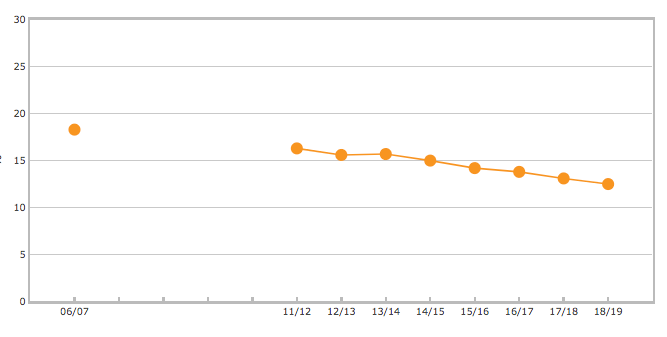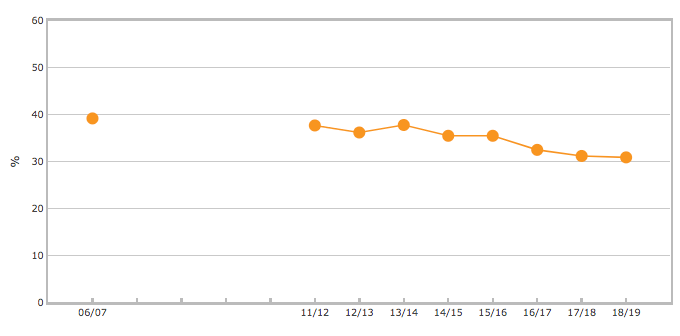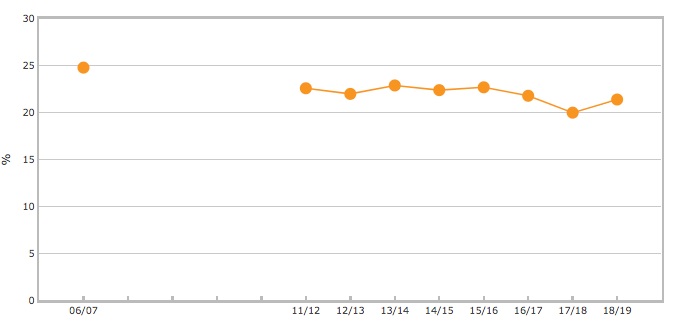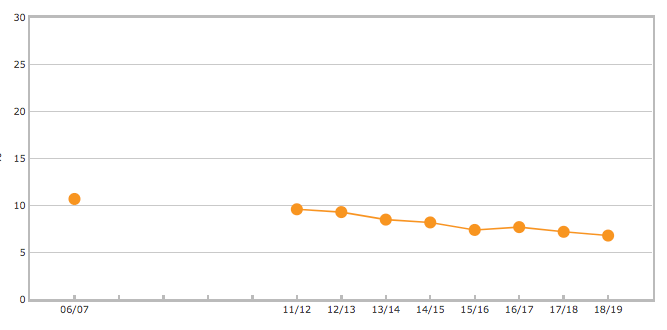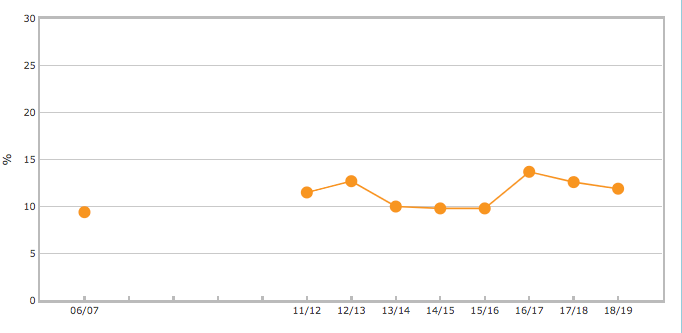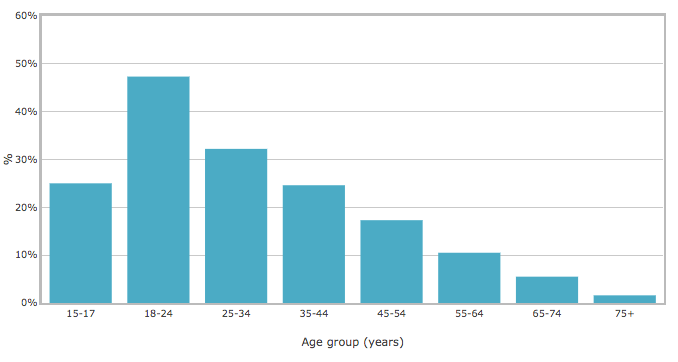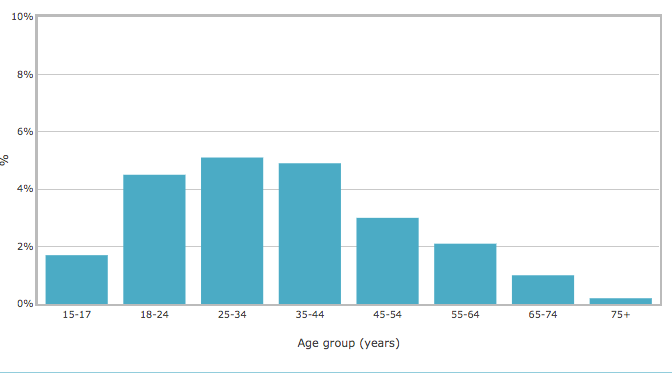New NZ Health Survey data show some encouraging recent reductions in smoking prevalence. However, progress remains inadequate to achieve the Smokefree Aotearoa 2025 goal and the government needs to take urgent action, particularly to reduce marked disparities for Māori and Pacific peoples. The data also show increased uptake of e-cigarettes/vaping over the last 3-4 years, but the contribution of vaping to helping achieve the smokefree goal is not yet clear.
Introduction
This blog provides a summary of some key points from the 2018-19 NZ Health Survey (NZHS) data as available on the 2018-19 annual data explorer website (https://minhealthnz.shinyapps.io/nz-health-survey-2018-19-annual-data-explorer/). The figures reported are unadjusted prevalences [1] from NZHS surveys conducted in 2006/7 and annually from 2011/12 to 2018/19. For simplicity only data and graphs available from the explorer website are described and displayed.
Key findings
1. Overall smoking prevalence trends
Overall smoking prevalence in 2018/19 was 12.5% for daily smoking (490,000 smokers) and 14.2% for current smoking (558,000 smokers). Both measures declined at about 0.5-0.6% in absolute terms per year from 2011/12 to 2018/19 (figure 1). If this rate of decline continued to 2025/26, daily smoking prevalence would be 8.7% and current smoking prevalence 10.2%. Based on these data, Smokefree Aotearoa 2025 (minimal smoking prevalence by 2025) will not be achieved.
Figure 1: Daily smoking among NZ adults aged > 15 years
2. Smoking prevalence trends among Māori
Māori daily smoking prevalence was 30.9% (143,000 smokers) and current smoking prevalence 34.0% (157,000) in 2018/19. Daily smoking prevalence decreased by almost 1% per year in absolute terms and current smoking prevalence by 0.9% per year from 2011/12 to 2018/19 (figure 2), although daily smoking prevalence changed little between 2017/18 (31.2%) and 20918/19 (30.9%). If the average rate of decline since 2011/12 continued to 2025/26, current smoking prevalence would be 27.8% and daily smoking prevalence 24.1%.
Based on these data, very substantial disparities in smoking persist and Smokefree Aotearoa 2025 is nowhere near on track to be achieved for Māori, and is likely to be missed by a very large margin.
Figure 2: Daily smoking among Māori adults aged > 15 years
3. Smoking prevalence trends among Pacific peoples
Pacific daily smoking prevalence was 21.4% (56,000 smokers) and current smoking prevalence 24.4% (64,000 smokers) in 2018/19. Daily and current smoking prevalence both decreased by around 0.2% per year in absolute terms from 2011/12 to 2018/19 (figure 3). If this rate of decline continued to 2025/26, smoking prevalence would decline to 23.1% and daily smoking prevalence to 20.2%. There was an increase in daily smoking prevalence between 2017/18 (20.0%) and 2018/19 (21.4%), although variations between consecutive years should be viewed with caution due to possible sampling variation.
Based on these data, very substantial disparities in smoking persist and Smokefree Aotearoa 2025 is (as for Māori) way off track for Pacific peoples and is likely to be missed by a very large margin.
Figure 3: Daily smoking among Pacific adults aged > 15 years
4. Smoking among adolescents
Daily smoking prevalence was 3.0% (6,000 smokers) and current smoking prevalence 3.8% (8,000 smokers) in 2018/19 among 15-17 year olds. Current smoking prevalence roughly halved between 2006/7 (15.7%) and 2011/12 (8.1%) in this age group, an absolute reduction of about 1.5% per year. Prevalence then halved again by 2016/17 (3.9%), a reduction of about 0.8% per year. Since then current smoking prevalence has remained more or less the same. The patterns of prevalence over time were very similar for daily smoking. The figures suggest that only a small minority of adolescents are smokers at the age of 15-17 years, and that this figure has declined dramatically since 2006/7 but plateaued since 2016/17. Figures for smoking among adolescents by ethnicity are not available in the data explorer, though data from surveys such as the ASH Snapshot survey have found substantial disparities in smoking prevalence by ethnicity among Year 10 students [1].
5. Smoking among young adults
Daily smoking prevalence was 15.0% (67,000 smokers) and current smoking prevalence 19.2% (86,000 smokers) in 2018/19 among 18-24 year olds. Current smoking prevalence did not change greatly between 2006/7 (27.7%) and 2011/12 (27.3%) but then declined at almost 1.5% per year to 20.0% by 2016/17. Since then, current smoking prevalence has declined by only 0.4% per year. The patterns of prevalence over time were very similar for daily smoking. The figures show that almost a fifth of young adults in 2018/19 were current smokers. This figure declined between 2011/12 and 2016/17 but the rate of decline had slowed since 2016/17. Uptake of smoking therefore continues to contribute to maintaining a substantial level of smoking among the adult population in Aotearoa. Figures for smoking among young adults by ethnicity are not available in the data explorer.
6. Smoking by socio-economic status in 2018/19
Current smoking prevalence in 2018/19 was almost four times higher among the most deprived quintile of the population (26.4%, 197,000 smokers) than the least deprived quintile (7.2%, 57,000 smokers) based on the NZDep measure of neighbourhood deprivation. Daily smoking was over four times higher in the most deprived quintile (24.0%, 179,000 smokers) than in the least deprived quintile (5.6%, 45,000 smokers).
Based on these data, very substantial disparities in smoking persist and Smokefree Aotearoa 2025 is not on track to be achieved, and is likely to be missed by a very large margin by people among the most deprived populations.
7. Proportion of heavy smokers among daily smokers
The proportion and number (34,000) of all daily smokers (490,000) who are heavy smokers (≥ 21 cigarettes per day) is low and decreasing, with the proportion declining steadily since 2006/7 (10.7%) to 2018/19 (6.8%) (figure 4).
Figure 4: Proportion of heavy smokers (≥ 21 cigarettes per day) among daily smokers
The mean number of cigarettes smoked per day among daily smokers has also declined (11.5 in 2006/7 and 10.0 in 2018/19). Mean cigarettes per day also declined steadily for Māori smokers from 11.7 in 2011/12 to 10.4 in 2018/19, but whilst the proportion of heavy smokers fell from 2006/7 (9.7%) to 2014/15 (7.6%), since then it has remained about the same (7.8% in 2018/19).
The 2018/19 data therefore provides no evidence that as smoking prevalence has declined over time, the population of smokers in Aotearoa increasingly consists of heavy smokers. That is, it fits with most international data on this topic which does not support the ‘hardening hypothesis’ which proposes that as smoking prevalence declines the remaining smokers include a progressively greater proportion of more heavily addicted smokers who find it harder to quit [2].
8. Quit rates
Estimated recent (in the last year) quit rates among daily smokers were 11.9% in 2018/19 (representing 66,000 quitters in the last year). Quit rates were highest among young adults (15.7%). There are no consistent trends in recent quit rates over time (figure 5), though quit rates may have been higher from 2016/17 to 2018/19 than from 2013/14 to 2015/16.
Figure 5: Recent quit rates (last 12 months) among daily smokers
There were concerning disparities in quit rates by:
- Ethnicity: Māori (7.7% of daily smokers; 12,000 recent quitters), Pacific 6.9% (4,000 recent quitters), Asian 12.4% (6,000 recent quitters) and European/Other 14.1% (53,000 recent quitters);
- Deprivation: quintile 5 (most deprived) at 9.0% vs quintile 1 (least deprived) at 17.2%.
9. Trends in use of e-cigarettes
The proportion of the population that has ever tried e-cigarettes/vaping increased from 16.2% in 2015/16 to 21.2% in 2018/19, with substantial increases occurring among all age groups aged <55 years, men and women, and among all ethnicities.
Regular use of e-cigarettes (at least monthly in the adult population) increased from 1.4% in 2015/16 to 4.7% in 2018/19. Substantial increases in regular use occurred among all age groups aged <75 years, men and women, and among all ethnicities. The largest proportionate and absolute increase by ethnicity occurred among Māori from 2.4% in 2015/16 to 8.2% in 2018/19.
Daily use of e-cigarettes increased from 0.9% in 2015/16 to 3.2% in 2018/19. Substantial increases in regular use occurred among all age groups aged <75 years, men and women, and among all ethnicities.
10. Patterns of use of e-cigarettes in 2018-19
Ever use of e-cigarettes/vaping in 2018/19 was 21.2% (836,000 people). Prevalence of ever use of e-cigarettes varied greatly by age with the highest prevalence in the 18-24 year old age group (47.3%) and much lower prevalence among older age groups (e.g. 5.5% 65-74 years, 1.6% ≥ 75 years) (Figure 6).
Figure 6: Age distribution of ever use of e-cigarettes 2018/19
Māori were almost twice as likely to have tried e-cigarettes than non-Māori (age and gender adjusted odds ratio [OR] = 1.95 (95%CI: 1.81-2.11) with 43.2% of Māori adults (199,000) reported having tried e-cigarettes. Trying e-cigarettes was about twice as common among adults in the most deprived quintile (28.8%) as for adults in the least deprived quintile (14.0%).
An estimated 4.7% (184,000) of adults were using e-cigarettes at least monthly with a similar age distribution to that for ever trying e-cigarettes – peaking at 8.8% among 18-24 year olds. Regular use was more common among Māori (6.6%), with an adjusted OR of 1.65 (95%CI: 1.34-2.02) for Māori vs non-Māori; and the most deprived (6.8%), adjusted OR of 2.05 (95%CI: 1.34-3.13) for most vs least deprived.
An estimated 3.2% (125,000) of adults were using e-cigarettes daily in 2018/19 with the highest prevalences (>4%) of daily use for those aged between 18-44 years (figure 7).
Figure 7: Age distribution of daily use of e-cigarettes 2018/19
Men (adjusted OR 1.78, 95%CI: 1.40-2.27) were more likely to be daily users. The highest prevalence of use by ethnicity was among Māori (5.5%, 25,000 daily use) and people in the most deprived areas (4.8%, 36,000 daily users).
Data on e-cigarette use available through the NZHS data explorer website are not reported by smoking status (e.g. current, ex, never smoker), which is a major limitation.
Commentary
The 2018/19 NZHS data on smoking and e-cigarette use reveal steady but unspectacular progress in reducing smoking prevalence. However, NZ is clearly not on track to achieve the Smokefree Aotearoa Goal, and current tobacco control strategies are not adequately addressing smoking disparities for Māori, Pacific and low SES populations. Quit rates among smokers have not changed greatly since the smokefree goal was adopted in 2011, and there are worrying disparities in quit rates by ethnicity and socio-economic status. After some initial promising reductions in uptake among young people, progress appears to have slowed recently, and smoking uptake continues at an unacceptably high level among young adults. Overall the picture is very concerning and indicates an urgent need to adopt more innovative and radical interventions.
The figures reveal a steady increase in the trial, regular and daily use of e-cigarettes/vaping from 2015/16 to 2018/19. This increase has not been accompanied by any notable acceleration in reductions in smoking prevalence or an increase in quit rates, as might be expected if e-cigarettes were encouraging and supporting large numbers of smokers to quit or transition away from smoking to vaping. Trial, regular and daily use of e-cigarettes from 2015/16 to 2018/19 has not coincided with increases in adolescent or young adult smoking, as would be anticipated if vaping was acting as a ‘gateway’ to smoking. Nonetheless, it has coincided with a period when previous declines in smoking prevalence among adolescents plateaued and when the rate of decline in smoking prevalence slowed among young adults. This may suggest an adverse impact of e-cigarettes on adolescent and young adult smoking uptake, though the evidence is far from definitive.
Observations of the impact of e-cigarettes/vaping on smoking uptake, quitting and prevalence are very preliminary and somewhat conjectural for multiple reasons, including:
- The data will not reflect recent changes, which may have resulted in more aggressive marketing and greater availability of e-cigarettes/vaping devices and products;
- Smoking cessation and uptake may be affected by other factors, such as the annual increases in tobacco taxation and the introduction of standardised packaging and revised health warnings in 2018;
- Lack of more detailed data on e-cigarette use such as prevalence of use by smokers, ex-smokers and never smokers and use of e-cigarettes for quitting.
The figures available through the data explorer are informative, but more in-depth analysis is required on some key aspects of smoking and vaping in Aotearoa – important gaps in the data available include the prevalence of smoking by ethnicity among adolescents and young adults, and patterns of e-cigarette use in relation to smoking status.
However, the overall picture is clear at least in one respect, inadequate progress means we must intensify efforts to achieve Smokefree 2025. The urgent need for a clear regulatory framework for e-cigarettes/vaping has been identified in an open letter to the Health Minister by researchers and over 60 health, community and school organisations. In addition, we require a clear government commitment to achieving the Smokefree Aotearoa goal and the implementation of a comprehensive government strategy that includes broad population-based ‘game-changer’ measures designed to support quitting and reduce smoking uptake, particularly among Māori, Pacific populations, and other high prevalence groups. Such game-changer measures could include tackling policy and intervention areas that are currently unaddressed, such as greatly reducing the supply of tobacco products and regulating smoked tobacco products (e.g. removing most or all of the nicotine) as set out in the ASAP Strategy [3].
[1] Footnote: Because the prevalences are unadjusted they could be affected by differences due to sampling variation or change in the demographics (age structure, ethnicity distributions) of the populations between surveys.


